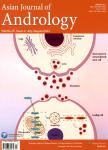Estimate of oxygen consumption and intracellular zinc concentration of human spermatozoa in relation to motility
ESTIMATE OF OXYGEN CONSUMPTION AND INTRACELLULAR ZINC CONCENTRATION OF HUMAN SPERMATOZOA IN RELATION TO MOTILITY作者机构:Center for Dermatology and Andrology University D-35385 Giessen GermanyCenter for Dermatology and Andrology University D-35385 Giessen GermanyInstitute for Plant Ecology University D-35385 Giessen GermanyCenter for Internal Medicine Justus Liebig University D-35385 Giessen GermanyCenter for Dermatology and Andrology University D-35385 Giessen Germany
出 版 物:《Asian Journal of Andrology》 (亚洲男性学杂志(英文版))
年 卷 期:2003年第5卷第1期
页 面:3-8页
核心收录:
学科分类:1001[医学-基础医学(可授医学、理学学位)] 10[医学]
主 题:oxygen energy consumption human spermatozoa sperm motility zinc
摘 要:Aim: To investigate the human sperm oxygen/energy consumption and zinc content in relation to motility. Methods: In washed spermatozoa from 67 ejaculates, the oxygen consumption was determined. Following calculation of the total oxygen consumed by the Ideal Gas Law, the energy consumption of spermatozoa was calculated. In addition, the zinc content of the sperm was determined using an atomic absorption spectrometer. The resulting data were correlated to the vitality and motility. Results: The oxygen consumption averaged 0.24μmol/106 sperm×24 h, 0.28μmol/106 live sperm×24 h and 0.85μmol/106 live & motile sperm×24 h. Further calculations revealed that sperm motility was the most energy consuming process (164.31 mJ/106 motile spermatozoa×24 h), while the oxygen consumption of the total spermatozoa was 46.06 mJ/106 spermatozoa×24 h. The correlation of the oxygen/ energy consumption and zinc content with motility showed significant negative correlations (r= -0.759; P0.0001 and r=-0.441; P0.0001, respectively). However, when correlating sperm energy consumption with the zinc content, a significant positive relation (r=0.323; P=0.01) was observed. Conclusion: Poorly motile sperm are actually wasting the available energy. Moreover, our data clearly support the Geometric Clutch Model of the axoneme function and demonstrate the importance of the outer dense fibers for the generation of sperm motility, especially progressive motility.



